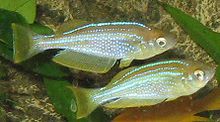
Lake Tanganyika is an African Great Lake. It is the second-largest freshwater lake by volume and the second deepest, in both cases after Lake Baikal in Siberia. It is the world's longest freshwater lake. The lake is shared among four countries—Tanzania, the Democratic Republic of the Congo, Burundi, and Zambia—with Tanzania (46%) and the DRC (40%) possessing the majority of the lake. It drains via the Lukuga River into the Congo River system, which ultimately discharges at Banana, Democratic Republic of the Congo into the Atlantic Ocean.

Synodontis multipunctatus, also known as the cuckoo catfish, cuckoo squeaker, or multipunk, is a small catfish from Lake Tanganyika, one of the lakes in the Great Rift Valley system in Africa. It is a brood parasite upon mouthbrooding cichlids. This species grows to a length of 27.5 centimetres (10.8 in) TL. This species is a minor component of local commercial fisheries.
Chelaethiops minutus is a species of ray-finned fish in the family Cyprinidae. It is endemic to Lake Tanganyika and its outflow, the Lukuga River and is found in Burundi, Democratic Republic of the Congo, Tanzania, and Zambia.

Altolamprologus compressiceps is a species of fish in the family Cichlidae. It is endemic to the shallow rocky areas of Lake Tanganyika. It is not considered threatened by the IUCN.
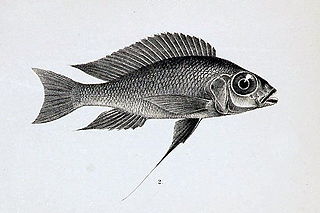
Cunningtonia longiventralis is a species of cichlid endemic to Lake Tanganyika in East Africa where it is found near rocky shores. It eats floating plankton. This species reaches a length of 14 centimetres (5.5 in) TL. It can also be found in the aquarium trade. As of 2011 it is the only known member of its genus. The generic name honours the British zoologist and anthropologist William Alfred Cunnington (1877-1958), the leader of the expedition to Lake Tanganyika during which type was collected.
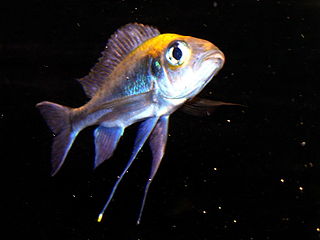
The featherfin cichlid is a species of cichlid endemic to Lake Tanganyika where it is found off rocky slopes. It feeds on plankton. This fish can reach a length of 21 centimetres (8.3 in) TL. It can also be found in the aquarium trade. This is currently the only species recognized in the genus by FishBase, but genetics and morphology suggest there are two valid species. The second is frequently called C. foae in the aquarium trade, but a review of the type specimen is needed to clarify if this is the correct name.
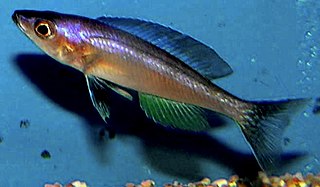
Cyprichromis leptosoma is a mouthbrooding species of fish in the family Cichlidae. It is endemic to Lake Tanganyika in Zambia and Tanzania. It seems quite common within its range and faces no particular threats, so the International Union for Conservation of Nature has assessed its conservation status as being of least concern.

Haplotaxodon microlepis is a species of fish in the family Cichlidae. It is endemic to Lake Tanganyika in Burundi, the Democratic Republic of the Congo, Tanzania, and Zambia. The adults spend most of their time in the open waters of the lake, either solitarily or in pairs. They sometimes form schools near the shores where there are rocky shorelines. They feed on zooplankton. Both parents mouthbrood the young until the attain a total length of 2.34 centimetres (0.92 in).
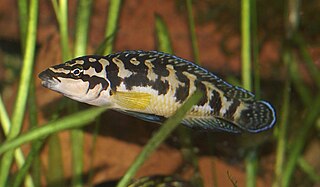
The masked julie is a species of cichlid endemic to Lake Tanganyika in Africa where it is found only along the northwestern shore preferring areas with rocky substrates. They eat zooplankton and benthic invertebrates found in the algae growth in the wild. This species reaches a length of 7 centimetres (2.8 in) TL.

The Lake Tanganyika sardine is a species of freshwater ray-finned fish in the family Dorosomatidae which was endemic to Lake Tanganyika but which has now been introduced to other lakes in Africa as a food source. It is one of two species within the genus Limnothrissa, the other being the Lake Mweru endemic, L. strappersi. This species and the Lake Tanganyika sprat are known collectively as kapenta.

Limnotilapia dardennii, the latticed cichlid, is a species of cichlid endemic to Lake Tanganyika, where it prefers rocky areas near the coast. It may also be found in the aquarium trade. This species is currently the only known member of its genus.
Mastacembelus ophidium is a species of fish in the family Mastacembelidae. It is endemic to Lake Tanganyika where it is a secretive fish, hiding in the sediment or between rocks on sandy shores.

Neolamprologus fasciatus is a species of cichlid endemic to Lake Tanganyika. This species spawns in empty snail shells. This species can reach a length of 15 centimetres (5.9 in) TL. This species can also be found in the aquarium trade. They are piscivores and their prey includes the cichlid fish Variabilichromis moorii.

Neolamprologus mondabu is a species of cichlid endemic to Lake Tanganyika except for the southern portion where it is replaced by N. modestus. It prefers areas with rocky substrates, moving to areas with sandy substrates to breed. It feeds on the eggs of Lamprichthys tanganicanus. This species can reach a length of 10.7 centimetres (4.2 in) TL. This species can also be found in the aquarium trade.
Neolamprologus niger is a species of cichlid endemic to Lake Tanganyika where it is only found along the northern shores. It is a crevice-dweller and feeds on molluscs. This species reaches a length of 9 centimetres (3.5 in) TL. It can also be found in the aquarium trade.
Neolamprologus petricola is a species of cichlid endemic to Lake Tanganyika where it is only known from the shores of the Democratic Republic of the Congo. This species reaches a length of 14 centimetres (5.5 in) TL. It can also be found in the aquarium trade.

Ophthalmotilapia boops is a species of fish in the cichlid endemic to Lake Tanganyika where it is only known from along the southern shore of the lake. It can reach a length of 15 centimetres (5.9 in) TL. It can also be found in the aquarium trade.
Xenotilapia tenuidentata is a species of cichlid endemic to Lake Tanganyika where it is only known from the western shore. This species can reach a length of 8 centimetres (3.1 in) TL. It can also be found in the aquarium trade. Some authorities place this species in the genus Microdontochromis along with Xenotilapia rotundiventralis, with X. tenuidentata as the type species.
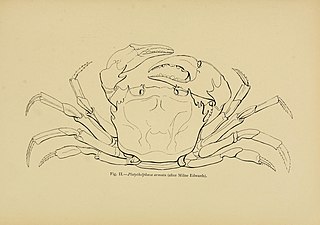
Platythelphusa is a genus of freshwater crabs endemic to Lake Tanganyika. It has been placed in a number of families, including a monotypic family, Platythelphusidae, as well as Potamidae and its current position in the Potamonautidae, and has also been treated as a subgenus of Potamonautes. It forms a monophyletic group, possibly nested within the genus Potamonautes, which would therefore be paraphyletic. The genus is the only evolutionary radiation of crabs to have occurred in a freshwater lake, and it occurred recently, probably since the Pliocene. This parallels the better known radiation of cichlid fishes in Lake Tanganyika. Only one other species of freshwater crab is found in Lake Tanganyika, Potamonautes platynotus.

Mastacembelus ellipsifer is a species of spiny eel that is endemic to Lake Tanganyika in Africa and sometimes kept in aquariums. Although sometimes called the Tanganyikan spiny eel, it is only one of fifteen spiny eel species in the Tanganyikan basin.
